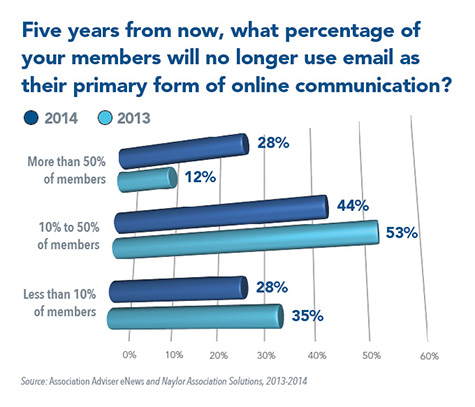Members of All Ages Less Likely to Be Using Email
Sure, your inbox is stuffed to the gills. But if you think you’ve been getting more text, tweets, updates and posts than ever before, you’re not alone. According to our latest unscientific reader poll, 72 percent of respondents (up from 65 percent in 2013) believe that at least 10 percent of members will not be using email as their primary online communication tool by 2019. In fact, 28 percent of respondents (vs. 12 percent in 2013) think that more than half of their members will not be email regulars within the next half decade.

Not only is membership skewing younger each year, but our research shows that more than half (54 percent) of Association Adviser eNews followers say they are either texting or planning to text members within the next 12 months. A Boston Globe report found that for many people, especially the young, Twitter, Facebook and other social networks have messaging systems built in that replicate the direct–and private–contact email provides. Unlike email, experts say social networking more closely resembles the natural flow of conversation, which adds to its immediacy and appeal.
For corporate users, enterprise networking solutions from IBM, Salesforce.com and Yammer, for example, are like virtual workplaces that combine the functionality of multiple programs, from email to logistics to content production. In these closed networks, employees can share files, show work in progress, and have personal and group conversations or communications using text, pictures or live video, without switching back and forth among multiple programs.
Finally, it’s not all cutting-edge technology that’s eating into email. Frank Rudd of the Florida Society of Association Executives (FSAE) and Rita Chen Fujisawa of the California Association of Health Facilities (see today’s Corner Office profile) said faxing is making a comeback, especially at organizations whose members are not “early adopters” of technology. CAHF members not always in front of their PCs, Fujisawa said, and a fax signifies more importance than an email, text or phone message.
Many of our recent polls are still open. Visit today and tell us where you stand.

